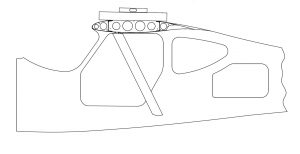 When to align wing angle of incidence: We have worked on 20+ Glastar projects, and this problem constantly arises. I can not stress strongly enough that the time to correct this problem is when you first attach the wings to the fuselage and are able to measure the difference in the incidence of the wings. If you were to wait to address this problem after you have completed the airplane, it is extremely difficult to remedy the problem correctly at that time due to the need to modify the fiberglass junction to the wing (top deck and quarter hatches would have to be realigned). Any other suggestions for compensating for a heavy wing due to angle of incidence differences is only a bandaid remedy. The problem with trim tabs and re rigging control surfaces is that it decreases your speed by creating more resistance.
When to align wing angle of incidence: We have worked on 20+ Glastar projects, and this problem constantly arises. I can not stress strongly enough that the time to correct this problem is when you first attach the wings to the fuselage and are able to measure the difference in the incidence of the wings. If you were to wait to address this problem after you have completed the airplane, it is extremely difficult to remedy the problem correctly at that time due to the need to modify the fiberglass junction to the wing (top deck and quarter hatches would have to be realigned). Any other suggestions for compensating for a heavy wing due to angle of incidence differences is only a bandaid remedy. The problem with trim tabs and re rigging control surfaces is that it decreases your speed by creating more resistance.
From first hand experience, the maximum allowable error for the wings incidence differential should be .0 or as close as you can get. I have flown planes with small amounts of differential incidences and was able to distinguish this error in flight.
One of the most important items which we stress to others during the construction process is that the angle of incidence of the wings be exactly the same, no ifs ands or buts. We can not over emphasize the importance of checking this prior to step #31 in Systems installation. As Bill Jones mentioned the recommended allowable twist by Stoddard-Hamilton is unacceptable. During our builder assistance we strive to achieve zero zero difference from the right to the left wing. We have flown airplanes with small amounts of twist (i.e. 3/10 to 5/10) and found this to be totally unacceptable. To attempt to correct this after you have finished the aircraft with trim tabs and aileron deflections is counter productive as this contributes to drag and the complexity of trying to eliminate a heavy wing.
If you have completed the aircraft and then determined that your angle of incidence is incorrect and wish to correct this by modifying the aft spar wing pivot assembly (#101-02000-01) this can be done, however, at this late date your wing root faring and turtle deck hatches will need to be extensively modified. Needless to say the right time to address this problem is much earlier in construction.
We have worked on early run GlaStars which had substantial cage warpage which caused excessive difference in the angle of incidence from wing to wing. To Stoddard-Hamilton’s credit, they have greatly improved the more recent runs of fuselages, however the problem still exists and hopefully one day this will be completely eliminated from the production cages.
–Danny Defelici/AirLink
Wing Angle of Incidence: Stoddard-Hamilton sent out a letter saying that if you had more than (I believe) 0.5° of difference they would weld up a special swing fitting for you. They said no more than that difference because you would be putting the bolt into torsion rather than the shear that it is supposed to be under.
On our airplane we measured 0.3° difference and it worked out to a washer .082 thick. This is just a little thicker than a standard washer (approx. .062) and we plan to make a custom spacer out of 4130 or turn something on the lathe. You definitely want to do this before you put the wings on for the final time. Bill Jones did not, and says he regrets it.
–Tom Lempicke



